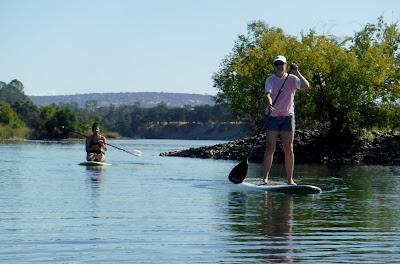Up until then, everything had been OK. But, then the road suddenly stopped! Being a road, that is. Huge ruts and massive rocks block our way. We sat at the point of turning around, going back and finding another way. Meadow Lake Road on the east end of Bowman Lake looked more like a mountain goat trail than a lane of travel.
In all my trips to the water, it's always been fairly simple. For trips to Lake Natoma or the Lower American River, stops signs, traffic, and parking spots are my biggest concerns. With a little luck, I'll squeeze into a spot at the boat ramp instead of having to park further away after dropping the kayak off at the water edge. For bigger trips, I'll leave the driveway, wade through traffic to the interstate, speed along to the exit, and end up getting stuck behind a slow-moving tractor or truck on the blacktop. At the crossing, I'll turn off the blacktop and drive on gravel down to the boat ramp.
"It’s the portage that makes traveling by canoe unique." said famed paddling guru Bill Mason. He, of course, was referring to hauling canoes through the northern woods from lake to lake. That's how it's done in places like the BWCA. Canoes are inserted on to lakes and streams and then carried by hand to other lakes and streams in between. Meanwhile, whitewater extremists will hike and climb miles transporting their kayaks up mountains to attempt the first descent of a waterfall or canyon creek. The paddling is the easy part, getting to the water is always the ordeal.
Our friend Curt Hough told me, it was a place we just had to paddle. High in the Sierra Nevada Mountains, Lake Foucherie is an outdoor paradise. Clear water, mountain views, and towering pines encompass the lake. It's a hidden and remote treasure that offers more that than just tranquil splendor, but serenity as well. It's so beautiful that photographer Ansel Adams just might have switched to color film to photograph its grandeur.
We gathered in my pickup with tandem kayak on top and looked forward to what naturalist John Muir described as an inexpressible delight of wading out into the grassy sun-lake when he wrote, "Feeling yourself contained in one of Nature's most sacred chambers, withdrawn from the sterner influences of the mountains, secure from all intrusion, secure from yourself, free in the universal beauty."
The Bowman Lake Road off of Highway 20 on the northern end of California's Nevada County is bumpy but well-traveled by four-wheel-drive pickup and Jeeps. It weaves and winds, mostly on gravel in a northerly fashion past Fuller Lake and then on up to the dam site.
The Meadow Lake Road begins just below Bowman Reservoir's Dam, turning off and winding up the mountain. The road is rocky and a bit unnerving with a steep drop off at ones the side. It would be a wonderful breath-taking view of the mountains and valley if I hadn't been holding my breath at the sight of the depth chasm.
About halfway up we came to our roadblock. There was just no way my truck could clear those ruts and rocks. We regrouped, turned around and went back down to find a different road up the mountain via GPS.
The first road must have been the express lane for four-wheel drivers and mountain goats. The other road adorned with switchbacks, but they still meet together for the same view Bowman Lake. At an elevation of 5,585 feet, the lake gleams through our windshield. Its fortress-like granite rock formations line the lake buffering it between the water and sky. The north side road runs parallel along the steep lakeshore. It was slow going, but, our destination seems to be in grasp.
All the way to the end of the lake and past Jackson Creek the road went from good to bad, to worse. My wife Debbie had taken the wheel now and she compared the road to a dried-up river bed.
The washboard grooves and stones tested the truck's tires and shock absorbers while driving up what looked like an evaporated stream.
I even got out of the truck and walked ahead in spots and clearing rocks and guiding Debbie to even ground.
At the Jackson Creek Campground, the road splits and leads to Sawmill Lake and Lake Foucherie. That road wasn't any better. It was a rugged adventurous drive over a parched creek bed and along a narrow pine-lined path.
When we limped into the Sawmill Lake Campground and saw the sight of Sawmill Lake, we agreed that we would just have to save Lake Foucherie for another day and unloaded our kayaks.
After the rigorous day of travel, the payoff came softly.
Sawmill Lake cooled us off in an instant. The water gave us relief, the pines refreshed us and the majestic mountain views mesmerized us with their beauty. It wasn't our original destination, but the wilderness always seems to sing to me. You made it! It was the journey that mattered and the adventure in just getting there. Now enjoy my serenity.
Naturalist Sigurd Olson thought of it that way. He said, "And that, I believe, is one of the reasons why coming home from any sort of a primitive expedition is a real adventure. Security and routine are always welcome after knowing the excitement and the unusual. We need contrast to make us know we are really alive."













































